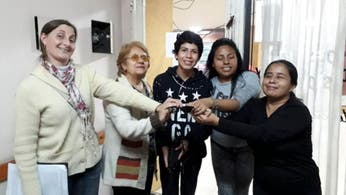Juggling. Who didn’t ever feel like a juggler, trying to get him to close the equation between work, childcare and home care, and our own fulfillment? Especially in this time of quarantine, in which the personal and institutional networks that collaborated to make the entire network work remained
in suspense
.
But it is precisely in this time of quarantine that the relevance of a task that is generally undervalued and that usually falls with greater weight was revealed.
about women
: to take care of others. For this reason, the doctor in Social Sciences Eleonor Faur, author of the book
Child care in the XXI century. Jugglers in an unequal society
(Siglo XXI), believes that confinement can be a great opportunity for caregiving to become a priority on the public agenda. “We must continue betting on the redistribution of tasks. If care is being shared much more in a home now than before quarantine, that memory must be maintained,” says Faur, also a professor at IDAES (Unsam).
What do we mean when we talk about care?
Care is a central issue of well-being. It refers to the care offered to different people, including oneself, to achieve that well-being. This attention has material aspects, but there are also emotional care, psychological care, care that makes guarantee the dignity of the other person. At the same time, the people who investigate these topics talk about direct and indirect care. Because to take care of a child, to socialize it, to raise it, it is necessary to feed it, bathe it, organize its school issues, but to do all that, you also need domestic work.
Why are they generally tasks that are associated with women?
That idea has been culturally constructed. From a biological substrate, which is that women can give birth and can breastfeed, a notion of gender has been built that distributed the works in a sexed way. This was not the case all life. After the Industrial Revolution, a certain form of society was organized between work and care, which supposed that men were going to be the providers of the homes and women were going to be the ones that were in charge of the reproduction of society, of raising children, domestic work, etc. That was widening a number of inequalities between men and women that persist to this day.
But there are women who have always worked productively …
It’s true, but fewer did. When, from the 1970s and 1980s, women’s job prospects became increasingly important, reproductive tasks were not divided in the same way.
What other myths about care persist?
That is the main one, but there are others. For example, that all women want to be mothers, or that women are better caregivers than men or other identities. There is also the other, the opposite, which is that now men take care as much as women. If you look at the statistics on the use of time, you can see that this is not the case, that some men out there care a little more than before, but that, on average, inequalities are still very important. And all this is also reflected in the way in which we educate our sons and daughters and in how, often, corners of play are reproduced in kindergartens.
Often when something happens to children, they ask for the mother. Is that also cultural?
Sure. Biological is only gestating and giving birth. Caring for a boy or a girl is not only to feed them but also to contain them when they are distressed, it is to try to be aware of their needs, it is to open listening for when they have a problem, all that is emotional care. These are spaces that women have happily occupied. The big question is why we think that only women can do it. And why, socially, this stereotype continues to be that we women do it better. We do it more and we are more trained in a large majority, but because care is something that is learned, it is learned by doing it.
What differences are there in how men and women use time?
What the surveys reflect is that, in general, men work a little more in remuneration than women, and women work in an unpaid way in direct and indirect care much more than men. When they have young children, these differences become more acute. If you look at homes where a heterosexual couple and children live, women, the more children under the age of twelve, they increase the number of hours invested in their care. It also increases the number of hours invested the poorer they are. When you see the boys, neither the number of children nor the level of income changes the number of hours invested in the care tasks.

Did the quarantine sharpen or close that gap?
It is difficult to think comparatively because we do not have a baseline and a common methodology to analyze it at this time. What is seen in a survey that a few days ago presented an organization called Grow. Gender and Work is that the care became much more intense. If before they were distributed to some extent with other institutions and, to a certain extent, there was a containment network, now everything is happening inside the home. Boys are seen to be performing a number of tasks. Now that said, it is also seen that there are still gender gaps. For example, cleaning, shopping, and even disinfecting activities are much more shared, and childcare and elder care tasks and support for school tasks are shared a little less. In total, women spend almost two hours a day more than men looking after their children. That is what the survey shows now. They spend an additional hour to accompany their sons and daughters in school tasks and spend almost an hour more than boys per day cooking, cleaning and disinfecting.
This should be exacerbated in single-parent homes.
Of course, all this is aggravated when two adults do not live together in the home. When you have a separated woman in the middle classes, who lives with her sons or daughters, accompanies school tasks and also telecommutes, the stress from overlapping activities is greater.
To think that in this quarantine, the notion of caring for yourself and caring for others is widespread …
True, but who are we neglecting in the meantime? Individual care is fine, everyone has to take care of themselves. But the challenge is to be able to find the depth of care and the urgent need to value it, because the world already neglects too much. And in a careless world, care is revolutionary.
Why do we underestimate the tasks of care?
Sure, there’s like a devaluation. Firstly, for this notion that, because we do it for love, it has no cost, it has no implication, we like to do it. In the modalities of how we were raised in the 20th century, the feminine had less relevance than the masculine and the remunerated had more relevance than the unpaid. The tasks of care, from all points of view, were blurred, even its social value, it seemed that the economy reproduced itself and that it did not need these tasks for that to happen.
What happens at the corporate and public policy level? These days the feeling of overflow is frequent, especially among women, due to all the tasks that overlap at home.
In companies, to give an example, it is always assumed that workers are going to have a network that will allow them to organize the care of their children, to organize the way in which houses are cleaned. That is far beyond even the companies and the possible will of those who carry them out. Because the organization of paid work assumes that there is going to be someone organizing the unpaid. Domesticity, house hygiene, raising children, etc. Every social organization of work has as a counterpart a social organization of care.
The challenge is to be able to find the depth of care and the urgent need to value it, because the world is already neglecting too much.
Eleonor Faur
In addition to gender differences, social differences are central to care management. While there are households that can pay for help, in others, there are those who stop taking care of their own to work taking care of others. What public policies could help balance this imbalance?
More care services are needed, more double-day care services, to make them compatible with working hours, because three or four hours a day in kindergartens is not enough either. More extended licenses are also required. In the private sector it is 90 days for moms and two days for dads. There is a very clear message that the legislation itself is giving: it is the mothers who care. It is necessary to redistribute care times, it is necessary to be able to sustain these times with income for families, so that they can allocate them to care, as equitably as possible in terms of gender and socioeconomic terms. Policies that allow better well-being and more care for the popular sectors must be emphasized. We have to think that there is no possible economy without care economy.
In many homes, caregiving tasks were redistributed more equitably after confinement. How to maintain good practices when quarantine ends?
I believe that from now on it must be shown much more clearly that care is an inescapable condition of well-being. And now that much of the paid economy has stopped, caring hasn’t. Because if care had stopped, we really wouldn’t have survived there, beyond COVID-19. Let us also improve the public policies that are necessary for care to be better organized and better redistributed socially and institutionally. The more they fall on families, the more social inequalities are taking place.
But is change feasible, when it comes to notions so ingrained in culture?
Yeah right. In fact, they are changing. What happens is that the change in the redistribution of care is still much slower than what was meant by women’s paid employment. But you have to keep betting on that redistribution, on that transformation, and if care is being shared much more in a home now than before quarantine, you have to keep that memory. If it is possible in quarantine, it has to be possible outside it.
ALSO
.
Publicado en el diario La Nación




